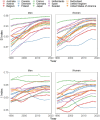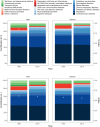On the measurement of cause of death inequality
- PMID: 38365965
- PMCID: PMC10873278
- DOI: 10.1093/ije/dyae016
On the measurement of cause of death inequality
Abstract
Background: Attempts at assessing heterogeneity in countries' mortality profiles often rely on measures of cause of death (CoD) diversity. Unfortunately, such indicators fail to take into consideration the degree of (dis)similarity among pairs of causes (e.g. 'transport injuries' and 'unintentional injuries' are implicitly assumed to be as dissimilar as 'transport injuries' and 'Alzheimer's disease')-an unrealistic and unduly restrictive assumption.
Development: We extend diversity indicators proposing a broader class of heterogeneity measures that are sensitive to the similarity between the causes of death one works with. The so-called 'CoD inequality' measures are defined as the average expected 'dissimilarity between any two causes of death'. A strength of the approach is that such measures are decomposable, so that users can assess the contribution of each cause to overall CoD heterogeneity levels-a useful property for the evaluation of public health policies.
Application: We have applied the method to 15 low-mortality countries between 1990 and 2019, using data from the Global Burden of Disease project. CoD inequality and CoD diversity generally increase over time across countries and sex, but with some exceptions. In several cases (notably, Finland), both indicators run in opposite directions.
Conclusions: CoD inequality and diversity indicators capture complementary information about the heterogeneity of mortality profiles, so they should be analysed alongside other population health metrics, such as life expectancy and lifespan inequality.
Keywords: Cause of death; dissimilarity; diversity; heterogeneity; mortality inequality; mortality profile.
© The Author(s) 2024. Published by Oxford University Press on behalf of the International Epidemiological Association.
Conflict of interest statement
None declared.
Figures



References
-
- Frenk J, Frejka T, Bobadilla JL et al. La transición epidemiológica en América Latina. Bol Oficina Sanit Panam (OSP) 1991;111:485–96. - PubMed
-
- Omran AR. The epidemiologic transition theory revisited thirty years later. World Health Stat Q 1998;53:99–119.
-
- Vallin J, Meslé F.. Convergences and divergences in mortality: a new approach of health transition. DemRes 2004;Special 2:11–44.
-
- Horiuchi S. Causes of death among the oldest-old: age-related changes in the cause-of-death distribution. In: Robine J-M, Crimmins EM, Horiuchi S, et al., eds. Human Longevity, Individual Life Duration, and the Growth of the Oldest-Old Population. Dordrecht: Springer, 2007;215–35.
MeSH terms
Grants and funding
LinkOut - more resources
Full Text Sources
Medical

